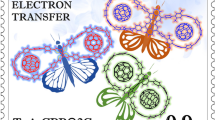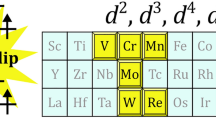Abstract
The one-sided Möbius band topology with its characteristic 180° twist has fascinated and inspired philosophers, artists and scientists since a long time. On the molecular level, only in the last 13 years a few chemistry groups succeeded to artificially create novel compounds with Möbius symmetry by theory-based molecular design and elaborate chemical synthesis. The interest in molecules with Möbius band symmetry was greatly stimulated in 1964 by a theoretical paper by Edgar Heilbronner from the ETH Zurich. He predicted that sufficiently large [n]annulenes with a closed-shell electron configuration of 4n π-electrons should allow for sufficient π-overlap stabilization to be synthesizable by twisting them into the Möbius topology of their hydrocarbon skeleton. In 2003, the first synthesis of an aromatic Möbius annulene was accomplished by Rainer Herges and co-workers in Kiel. In 2007, Lechosław Latos-Grażyński and co-workers in Wroclaw succeeded in synthesizing free-base di-p-benzi (Yoneda et al., Angew Chem Int Ed 53: 13169–13173, 2014) hexaphyrin (1.1.1.1.1.1), compound 1, an expanded porphyrin which can dynamically switch between Hückel and Möbius conjugation upon changes of solvent and temperature. Shortly thereafter, in 2008, Atsuhiro Osuka and his co-workers from Kyoto, Seoul and Hyogo published the synthesis of an expanded porphyrin in which metalation triggered the production of molecular twisting and Möbius aromaticity. In this minireview, among other studies also our recent EPR, ENDOR and DFT studies on open-shell states of 1, i.e., on the ground-state radical cation doublet state (total electron spin S = 1/2) and the first excited triplet state (S = 1) are summarized. The review is largely based on a previous joint publication of the current authors with the Latos-Grażyński group on radical cations of 1 (Möbius et al., Phys Chem Chem Phys 17:6644–6652, 2015). The radical cation study was the first one of an open-shell π-system with Möbius topology. In the doublet state, the hyperfine interactions of the unpaired electron spin with specific magnetic nuclei in the molecule was used as a sensitive probe for the electronic structure of the molecule and its symmetry properties. This work has now been extended to state-of-the-art DFT theory studies on photo-excited triplet states of 1. In the open-shell triplet state, besides hyperfine couplings, a change of the zero-field splitting interaction between the two unpaired electron spins is predicted to be a viable sensor for electronic structure changes upon Möbius-to-Hückel topology switching.







Similar content being viewed by others
References
K. Möbius, M. Plato, G. Klihm, C. Laurich, A. Savitsky, W. Lubitz, B. Szyszko, M. Stępień, L. Latos-Grażyński, Phys. Chem. Chem. Phys. 17, 6644–6652 (2015)
A.F. Möbius, Berichte über die Verhandlungen der Königlich Sächsischen Gesellschaft der Wissenschaften zu Leipzig; Sitzung am 27. November 1865, vol 11, pp. 31–68 (1865)
J.B. Listing, Abhandlungen der Mathematischen Classe der Königlichen Gesellschaft der Wissenschaften zu Göttingen; vorgetragen am 7. Dez. 1861, vol 10, pp. 97–182 (1861)
C.A. Pickover, The Möbius Strip: Dr. August Möbius’s Marvellous Band in Mathematics, Games, Literature, Art, Technology, and Cosmology (Basic Books, New York, 2006)
R. Herges, Naturwiss. Rundschau 58, 301–310 (2005)
R. Herges, Chem. Rev. 106, 4820–4842 (2006)
G.R. Schaller, R. Herges, Chem. Commun. 49, 1254–1260 (2013)
E. Heilbronner, Tetrahedron Lett. 29, 1923–1928 (1964)
M. Stępień, B. Szyszko, L. Latos-Grażyński, J. Am. Chem. Soc. 132, 3140–3152 (2010)
M. Stępień, N. Sprutta, L. Latos-Grażyński, Angew. Chem. Int. Ed. 50, 4288–4340 (2011)
Y. Tanaka, S. Saito, S. Mori, N. Aratani, H. Shinokubo, N. Shibata, Y. Higuchi, Z.S. Yoon, K.S. Kim, S.B. Noh, J.K. Park, D. Kim, A. Osuka, Angew. Chem. Int. Ed. 47, 681–684 (2008)
J.M. Lim, J.-Y. Shin, Y. Tanaka, S. Saito, A. Osuka, D. Kim, J. Am. Chem. Soc. 132, 3105–3114 (2010)
B. Szyszko, L. Latos-Grażyński, L. Szterenberg, Angew. Chem. Int. Ed. 50, 6587–6591 (2011)
C.-W. Chang, M. Liu, S. Nam, S. Zhang, Y. Liu, G. Bartal, X. Zhang, Phys. Rev. Lett. 105, 235501-1–235501-4 (2010)
E. W. Weisstein, http://mathworld.wolfram.com/MoebiusStrip.html. Accessed 1 July 2015
http://www.youtube.com/watch?v=xUHQ2ybTejU. Accessed 1 July 2015
M. Stępień, L. Latos-Grażyński, N. Sprutta, P. Chwalisz, L. Szterenberg, Angew. Chem. Int. Ed. 46, 7869–7873 (2007)
E. Hückel, Z. Physik. 70, 204–286 (1931)
E. Hückel, Z. Physik. 76, 628–648 (1932)
E. Hückel, Grundzüge der Theorie Ungesättiger und aromatischer Verbindungen (VCH, Berlin, 1938)
H.E. Zimmerman, J. Am. Chem. Soc. 88, 1564–1565 (1966)
T. Kawase, M. Oda, Angew. Chem. Int. Ed. 43, 4396–4398 (2004)
Z.S. Yoon, A. Osuka, D. Kim, Nat. Chem. 1, 113–122 (2009)
D. Ajami, O. Oeckler, A. Simon, R. Herges, Nature 426, 819–821 (2003)
D. Ajami, K. Hess, F. Koehler, C. Nather, O. Oeckler, A. Simon, C. Yamamoto, Y. Okamoto, R. Herges, Chem. Eur. J. 12, 5434–5445 (2006)
K. Moriya, T. Yoneda, S. Saito, A. Osuka, Chem. Lett. 40, 455–457 (2011)
K.S. Kim, Z.S. Yoon, A.B. Ricks, J.-Y. Shin, S. Mori, J. Sankar, S. Saito, Y.M. Jung, M.R. Wasielewski, A. Osuka, D. Kim, J. Phys. Chem. A 113, 4498–4506 (2009)
T. Yoneda, Y.M. Sung, J.M. Lim, D. Kim, A. Osuka, Angew. Chem. Int. Ed. 53, 13169–13173 (2014)
E. Vogel, Pure Appl. Chem. 68, 1355–1360 (1996)
E. Vogel, M. Broring, S.J. Weghorn, P. Scholz, R. Deponte, J. Lex, H. Schmickler, K. Schaffner, S.E. Braslavsky, M. Muller, S. Porting, C.J. Fowler, J.L. Sessler, Angew. Chem. Int. Ed. 36, 1651–1654 (1997)
J.L. Sessler, S.J. Weghorn, V. Lynch, M.R. Johnson, Angew. Chem. Int. Ed. 33, 1509–1512 (1994)
J.S. Sessler, S.J. Weghorn, Expanded, Contracted, and Isomeric Porphyrins (Elsevier, Amsterdam, 1997)
T.K. Ahn, J.H. Kwon, D.Y. Kim, D.W. Cho, D.H. Jeong, S.K. Kim, M. Suzuki, S. Shimizu, A. Osuka, D. Kim, J. Am. Chem. Soc. 127, 12856–12861 (2005)
M.-C. Yoon, P. Kim, H. Yoo, S. Shimizu, T. Koide, S. Tokuji, S. Saito, A. Osuka, D. Kim, J. Phys. Chem. B. 115, 14928–14937 (2011)
M. Torrent-Sucarrat, J.M. Anglada, J.M. Luis, J. Chem. Phys. 137, 184306-1–184306-9 (2012)
C. Castro, C.M. Isborn, W.L. Karney, M. Mauksch, P.V. Schleyer, Org. Lett. 4, 3431–3434 (2002)
H.S. Rzepa, Chem. Rev. 105, 3697–3715 (2005)
G. Bucher, S. Grimme, R. Huenerbein, A.A. Auer, E. Mucke, F. Koehler, J. Siegwarth, R. Herges, Angew. Chem. Int. Ed. 48, 9971–9974 (2009)
E.-K. Mucke, F. Koehler, R. Herges, Org. Lett. 12, 1708–1711 (2010)
M. Alonso, P. Geerlings, F. de Proft, Chem. Eur. J. 18, 10916–10928 (2012)
F. Neese, WIREs Comput. Mol. Sci. 2, 73–78 (2012)
K. Möbius, M. Plato, W. Lubitz, Phys. Rep. 87, 171–208 (1982)
M. Stępień, B. Szyszko, L. Latos-Grażyński, Org. Lett. 11, 3930–3933 (2009)
B. Szyszko, N. Sprutta, P. Chwalisz, M. Stępień, L. Latos-Grażyński, Chem. Eur. J. 20, 1985–1997 (2014)
H. Käss, J. Rautter, W. Zweygart, A. Struck, H. Scheer, W. Lubitz, J. Phys. Chem. 98, 354–363 (1994)
W. Zweygart, R. Thanner, W. Lubitz, J. Magn. Reson. 109, 172–176 (1994)
K. Möbius, R. Biehl, in Mulitiple Electron Resonance Spectroscopy, ed. by M.M. Dorio, J.H. Freed (Plenum, New York, 1979), pp. 475–507
W. Lubitz, R.A. Isaacson, E.C. Abresch, G. Feher, Proc. Natl. Acad. Sci. USA 81, 7792–7796 (1984)
A. Carrington, A.D. McLachlan, Introduction to Magnetic Resonance (Harper and Row, New York, 1969)
R.G. Parr, W. Yang, Density-Functional Theory of Atoms and Molecules (Oxford University Press, Oxford, 1989)
W. Koch, M.C. Holthausen, A Chemist’s Guide to Density Functional Theory (Wiley-VCH, Weinheim, 2000)
R. Ditchfield, W.J. Hehre, J.A. Pople, J. Chem. Phys. 54, 724–1000 (1971)
F. Weigend, R. Ahlrichs, Phys. Chem. Chem. Phys. 7, 3297–3305 (2005)
A. Klamt, G. Schüürmann, J. Chem. Soc. Perkin Trans. 2, 799–805 (1993)
N.M. Atherton, Principles of Electron Spin Resonance (Ellis Horwood, New York, 1993)
T. O’Have, http://terpconnect.umd.edu/~toh/spectrum/TOC.html Accessed 1 July 2015
M.N. Khan, C. Palivan, F. Barbosa, J. Amaudrut, G. Gescheidt, J. Chem. Soc. Perkin Trans. 2, 1522–1526 (2001)
A.D. Becke, J. Chem. Phys. 98, 5648–5652 (1993)
S. Sinnecker, F. Neese, J. Phys. Chem. A 110, 12267–12275 (2006)
G.R. Eaton, S.S. Eaton, D.P. Barr, R.T. Weber, Quantitative EPR (Springer, New York, 2010)
H. Kurreck, B. Kirste, W. Lubitz, Electron Nuclear Double Resonance Spectroscopy of Radicals in Solution (VCH Publishers, New York, 1988)
S.D. Chemerisov, O.Y. Grinberg, D.S. Tipikin, Y.S. Lebedev, H. Kurreck, K. Möbius, Chem. Phys. Lett. 218, 353–361 (1994)
K. Möbius, A. Savitsky, High-Field EPR Spectroscopy on Proteins and Their Model Systems: Characterization of Transient Paramagnetic States (RSC Publishing, London, 2009)
C.W.M. Kay, M. Di Valentin, K. Möbius, J. Chem. Soc. Perkin Trans. 2, 2563–2568 (1997)
C.E. Tait, P. Neuhaus, H.L. Anderson, C.R. Timmel, J. Am. Chem. Soc. 137, 6670–6679 (2015)
Z. Sun, J. Wu, J. Mater. Chem. 22, 4151–4160 (2012)
Z. Sun, Z. Zeng, J. Wu, Chem. Asian J. 8, 2894–2904 (2013)
W. Zeng, S. Lee, M. Son, M. Ishida, K. Furukawa, P. Hu, Z. Sun, D. Kim, J. Wu, Chem. Sci. 6, 2427–2433 (2015)
Acknowledgments
The authors acknowledge with gratitude the scientific cooperation with Lechosław Latos-Grażyński and his coworkers Marcin Stępień and Bartosz Szyszko at the University of Wroclaw who kindly provided the di-p-benzi [28]hexaphyrin (1.1.1.1.1.1) compound. We express our thanks to Rolf Trinoga, IT Group Leader at the MPI for Chemical Energy Conversion (CEC) in Mülheim (Ruhr), for his assistance in our ORCA-DFT calculations on the CEC Hermes computer cluster. We thank Gudrun Klihm and Christoph Laurich (CEC) for their essential contributions to the ENDOR experiments and sample preparations as well as Michal Zalibera (CEC) who is involved in the on-going triplet-state EPR experiments. We gratefully acknowledge support by the Max Planck Society and Free University Berlin. This work was additionally supported by the Excellence Cluster RESOLV (EXC 1069) funded by the Deutsche Forschungsgemeinschaft.
Author information
Authors and Affiliations
Corresponding authors
Rights and permissions
About this article
Cite this article
Möbius, K., Savitsky, A., Lubitz, W. et al. Möbius–Hückel Topology Switching in Expanded Porphyrins: EPR, ENDOR, and DFT Studies of Doublet and Triplet Open-Shell Systems. Appl Magn Reson 47, 757–780 (2016). https://doi.org/10.1007/s00723-016-0789-1
Received:
Revised:
Published:
Issue Date:
DOI: https://doi.org/10.1007/s00723-016-0789-1




